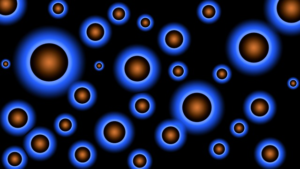
Unlike liquids or solids, whose atoms or molecules have greater correlation with each other, gas atoms and molecules move somewhat independently of each other.
This is to be expected. A gas occupies a much greater volume than a corresponding liquid.
This independent behavior allows us to calculate the root-mean-square velocity of gas particles directly from temperature.
Tweaking the Ideal Gas Law
We derive this equation from another well-known equation, the Ideal Gas Law equation. Algebraically, that equation is written:
PV = nRT
where P is pressure, V is volume (not velocity), n is the number of moles of gas, R is the ideal gas constant and T is the temperature.
By combining the above equation with derivatives of Boltzmann’s equation, we can determine the velocity of a particle from its temperature. However, it is important to realize that the temperature and the velocity of any one particle are statistically unlikely to equal those of the composite gas. Each particle moves independently. So we speak of the root-mean-square velocity of the bulk gas using the following equation:
Vrms = (3RT/M)1/2
It is important in our calculation to use units consistently. For example, if the molecular weight is in kilograms per mole and the ideal gas constant is in joules per mole per degree Kelvin, with the temperature is in degrees Kelvin, then the ideal gas constant is in joules per mole-degree Kelvin. The velocity is in meters per second.
A Sample Example
Let’s choose helium. Then the molar mass M is 0.004002 kilograms. At a temperature of 293 degrees Kelvin, with the ideal gas constant at 8.314 joules per mole-degree Kelvin, the root-mean-square velocity of the helium atom is:
Vrms = (3 x 8.314 x 293/0.004002)1/2 = 1351 meters per second.
Note: You might also enjoy Cooling Atoms to Millionths of 1 Degree by Laser?
References:
← Back to Quirky Science Nuggets
← Home

I’d like to add a comment — a speculative one. As molecules “collide” is there not some energy spent in imparting rotational motion to each of the pair? Is it significant? I should think it would be, especially at higher gas pressures.